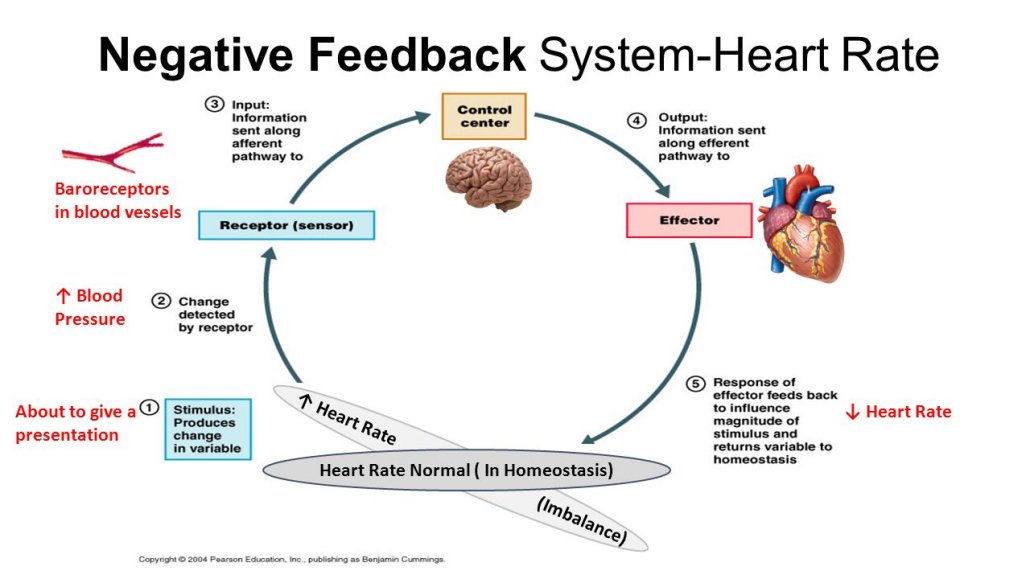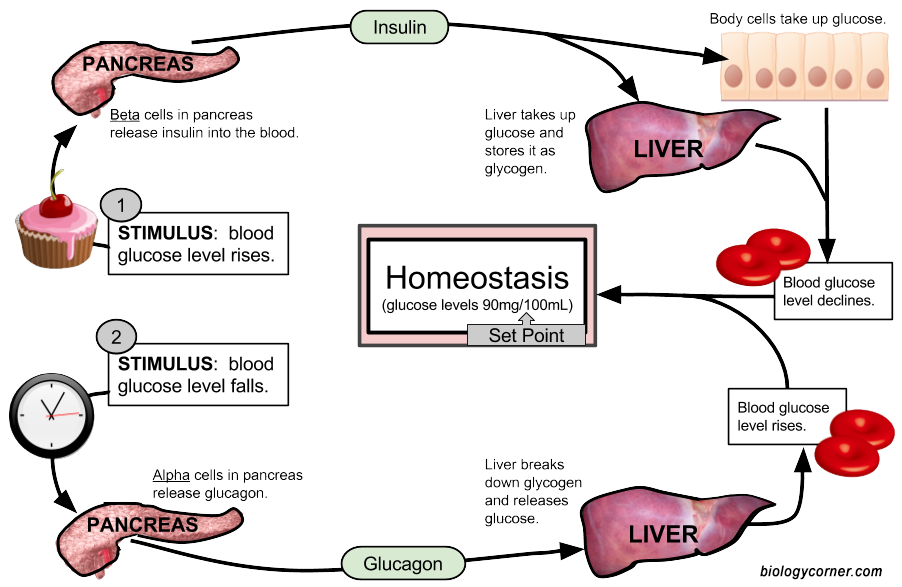Homeostasis
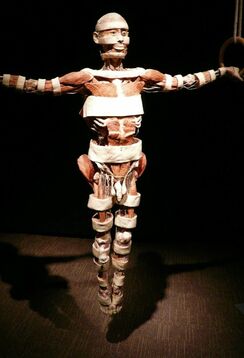
The major body systems work together to provide homeostasis. They do this through positive and negative feedback loops. Maintaining homeostasis requires that the body continuously monitors its internal conditions. Each of the body's physiological parameters has a SET POINT. The human body must maintain homeostasis within just a few points of the body's set point value. Without this, the body can quickly become out of balance and death can occur.
Your cells, tissues, organs, and organ systems all function to maintain homeostasis. Homeostasis is a state of balance that keeps certain physiological parameters within a fairly narrow range of values. Without homeostasis, the body quickly dies.
What is Homeostasis?
Homeostasis is the ability of the body's systems to maintain a stable, relatively constant internal environment.
Homeostasis is the tendency to resist change in order to maintain a stable, relatively constant internal environment.
Homeostasis refers to the maintenance of relatively constant internal conditions. For example, your body shivers to maintain a relatively constant body temperature when the external environment gets colder.
Homeostasis is the tendency to resist change in order to maintain a stable, relatively constant internal environment.
Homeostasis refers to the maintenance of relatively constant internal conditions. For example, your body shivers to maintain a relatively constant body temperature when the external environment gets colder.
How is Homeostasis Maintained?
- Homeostasis is maintained in the body through FEEDBACK LOOPS
- NEGATIVE FEEDBACK SYSTEMS - Homeostasis typically involves negative feedback loops that counteract changes of various properties from their target values, known as set points.
- POSITIVE FEEDBACK SYSTEMS - In contrast to negative feedback loops, positive feedback loops amplify their initiating stimuli, in other words, they move the system away from its starting state.
The body maintains homeostasis for many factors in addition to temperature. For instance, the concentration of various ions in your blood must be kept steady, along with pH and the concentration of glucose. If these values get too high or low, you can end up getting very sick.
Homeostasis is maintained at the cellular level, the organ level, the organ system level and the organism level!
For instance, the stomach maintains a pH that's different from that of surrounding organs, and each individual cell maintains ion concentrations different from those of the surrounding fluid. Maintaining homeostasis at each level is key to maintaining the body's overall function.
Homeostasis is maintained at the cellular level, the organ level, the organ system level and the organism level!
For instance, the stomach maintains a pH that's different from that of surrounding organs, and each individual cell maintains ion concentrations different from those of the surrounding fluid. Maintaining homeostasis at each level is key to maintaining the body's overall function.
Feedback Loops
Homeostasis is maintained through positive and negative feedback loops. There are 2 types of feedback loops; Negative and Positive. Control centers in the brain play roles in regulating physiological parameters and keeping them within the normal range. As the body works to maintain homeostasis, any significant deviation from the normal range will be resisted and homeostasis restored through a process called a feedback loop.
A feedback loop has three basic components:
A feedback loop has three basic components:
- Sensors / Receptors - Monitors the internal physiological parameter and reports changes to the Control Center
- The Control Center - Receives sensory input and compares the reported physiological parameter's value to the set point.
- Effectors - If the Control Center finds that the value of the physiological parameter is too far away from the set point, the control center will send a command to effectors. The effector will function to bring the physiological parameter closer to the set point. is the component in a feedback system that causes a change to reverse the situation and return the value to the normal range. Effectors are muscles and glands.
Negative Feedback Loop Schematic
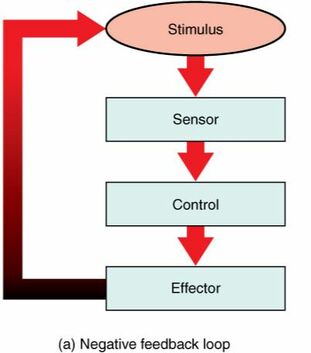
Negative feedback loops are the body’s most common mechanisms used to maintain homeostasis. Negative feedback works like driving car down the road. Constant adjustment to the right or left is required to keep the car on the road. A negative feedback system is one that tries to keep the body constant. Negative feedback is a mechanism in which the effect of the response to the stimulus is to shut off the original stimulus or reduce its intensity. In a negative feedback loop, when a mismatch is sensed by the control center, this deviation from the set point is resisted through a physiological process that returns the body to homeostasis.
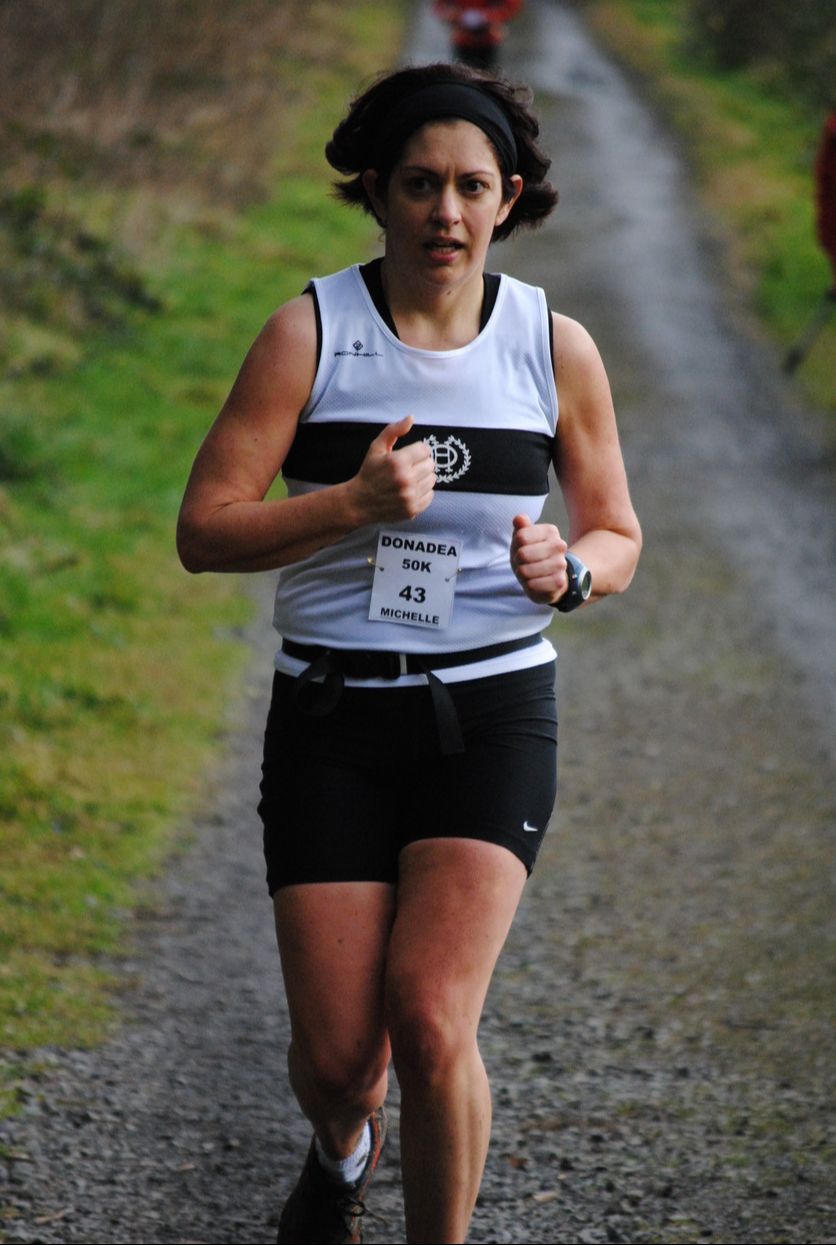
The body regulates its temperature through a process called thermoregulation. Thermoregulation is the ability of the body to maintain its temperature between ~36.5–37.5 °C (or 97.7–99.5 °F). In the process of ATP production by cells throughout the body, approximately 60 percent of the energy produced is in the form of heat used to maintain body temperature. Thermoregulation is an example of negative feedback.
The hypothalamus in the brain is the master switch that works as a thermostat to regulate the body’s core temperature. If the temperature is too high, the hypothalamus can initiate several processes to lower it. These include increasing the circulation of the blood to the surface of the body to allow for the dissipation of heat through the skin and initiation of sweating to allow evaporation of water on the skin to cool its surface. Conversely, if the temperature falls below the set core temperature, the hypothalamus can initiate shivering to generate heat. The body uses more energy and generates more heat. In addition, thyroid hormone will stimulate more energy use and heat production by cells throughout the body. An environment is said to be thermoneutral when the body does not expend or release energy to maintain its core temperature. For a naked human, this is an ambient air temperature of around 84 °F. If the temperature is higher, for example, when wearing clothes, the body compensates with cooling mechanisms. The body loses heat through the mechanisms of heat exchange.
The hypothalamus in the brain is the master switch that works as a thermostat to regulate the body’s core temperature. If the temperature is too high, the hypothalamus can initiate several processes to lower it. These include increasing the circulation of the blood to the surface of the body to allow for the dissipation of heat through the skin and initiation of sweating to allow evaporation of water on the skin to cool its surface. Conversely, if the temperature falls below the set core temperature, the hypothalamus can initiate shivering to generate heat. The body uses more energy and generates more heat. In addition, thyroid hormone will stimulate more energy use and heat production by cells throughout the body. An environment is said to be thermoneutral when the body does not expend or release energy to maintain its core temperature. For a naked human, this is an ambient air temperature of around 84 °F. If the temperature is higher, for example, when wearing clothes, the body compensates with cooling mechanisms. The body loses heat through the mechanisms of heat exchange.
Metabolic Rate
The metabolic rate is the amount of energy consumed minus the amount of energy expended by the body. The basal metabolic rate (BMR) describes the amount of daily energy expended by humans at rest, in a neutrally temperate environment, while in the post-absorptive state. It measures how much energy the body needs for normal, basic, daily activity.
The metabolic rate is the amount of energy consumed minus the amount of energy expended by the body. The basal metabolic rate (BMR) describes the amount of daily energy expended by humans at rest, in a neutrally temperate environment, while in the post-absorptive state. It measures how much energy the body needs for normal, basic, daily activity.

Let's look at the temperature regulation of the body as an example of a negative feedback loop. The negative feedback loop that regulates temperature can function to ultimately turn the internal temperature up or down as needed to get closer to the body's necessary set point.
When the brain’s temperature regulation center receives data from the sensors indicating that the body’s temperature exceeds its normal range, it stimulates a cluster of brain cells referred to as the “heat-loss center.”
When the heat loss center of the brain is triggered, the following 3 effects occur in efforts to decrease the internal body temperature:
When the brain’s temperature regulation center receives data from the sensors indicating that the body’s temperature exceeds its normal range, it stimulates a cluster of brain cells referred to as the “heat-loss center.”
When the heat loss center of the brain is triggered, the following 3 effects occur in efforts to decrease the internal body temperature:
- Blood Flow Redirection - Blood vessels in the skin begin to dilate allowing more blood from the body core to flow to the extremities and the surface of the skin. This allows for heat loos through the skin which cools the internal temperature.
- Sweating - Sweat glands are activated to increase their secretion of sweat. Sweat pools at the skin's surface and is evaporated as it touches the air. As the sweat evaporates from the skin surface into the surrounding air, it dissipates heat and cools the skin.
- Breathing Changes - The depth of respiration increases, and a person may breathe through an open mouth instead of through the nasal passageways. This further increases heat loss from the lungs.
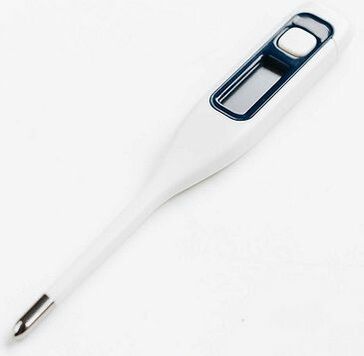
When the heat gain center of the brain is triggered, the following 3 effects occur in efforts to increase the internal body temperature:
- Blood Flow Redirection - Blood vessels in the skin begin to restrict the blood flow away from the body's extremities and away from the skin's surface, thereby conserving heat. The blood flow is diverted to the body's core to ensure that the vital organ continue normal function.
- Shivering - If heat loss is severe, the brain triggers muscle contraction known as shivering. The act of shivering releases heat while using up ATP.
- Metabolism Increase -
- Thyroid Hormone Release - The brain triggers the thyroid gland to release thyroid hormone, which increases metabolic activity and heat production in cells throughout the body.
- Epinephrine (Adrenaline) Release - The brain signals the adrenal glands to release epinephrine (adrenaline). Epinephrine is a hormone that causes the breakdown of glycogen into glucose, which can be used as an energy source. The breakdown of glycogen into glucose also results in increased metabolism and heat production.

Humans and other mammals must maintain an internal body temperature close to 98.6 degrees Fahrenheit or 37.0 degrees Celsius, despite how cold our external environment is. Our body's internal temperature must stay within a very narrow range of temperatures (between ~F95∘F/ C35∘C and F107∘F/ C41.7∘C) to avoid illness or even death.
|
Other negative feedback systems:
|
|
Positive Feedback Loops
Positive feedback intensifies a change in the body’s physiological condition rather than reversing it. A deviation from the normal range results in more change, and the system moves farther away from the normal range. Positive feedback in the body is normal only when there is a definite end point.
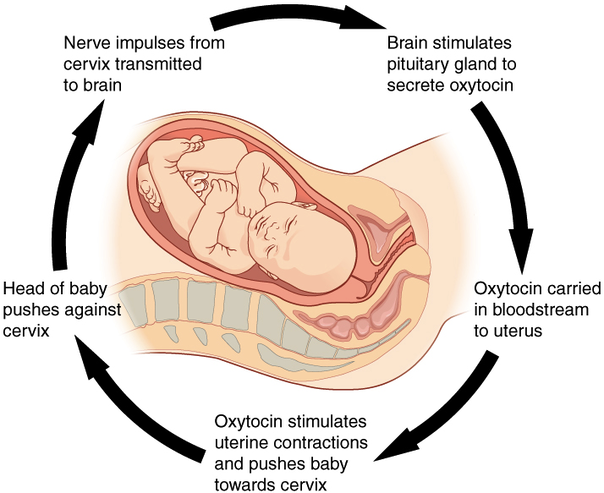
Positive feedback intensifies a change in the body’s physiological condition rather than reversing it. A deviation from the normal range results in more change, and the system moves farther away from the normal range. Positive feedback in the body is normal only when there is a definite end point. Childbirth and the body’s response to blood loss are two examples of positive feedback loops that are normal but are activated only when needed.
Childbirth at full term is an example of a situation in which the maintenance of the existing body state is not desired. Enormous changes in the mother’s body are required to expel the baby at the end of pregnancy. And the events of childbirth, once begun, must progress rapidly to a conclusion or the life of the mother and the baby are at risk. The extreme muscular work of labor and delivery are the result of a positive feedback system (Figure 1.11).
Figure 1.11. Positive Feedback Loop
Normal childbirth is driven by a positive feedback loop. A positive feedback loop results in a change in the body’s status, rather than a return to homeostasis.
The first contractions of labor (the stimulus) push the baby toward the cervix (the lowest part of the uterus). The cervix contains stretch-sensitive nerve cells that monitor the degree of stretching (the sensors). These nerve cells send messages to the brain, which in turn causes the pituitary gland at the base of the brain to release the hormone oxytocin into the bloodstream. Oxytocin causes stronger contractions of the smooth muscles in of the uterus (the effectors), pushing the baby further down the birth canal. This causes even greater stretching of the cervix. The cycle of stretching, oxytocin release, and increasingly more forceful contractions stops only when the baby is born. At this point, the stretching of the cervix halts, stopping the release of oxytocin.
Childbirth at full term is an example of a situation in which the maintenance of the existing body state is not desired. Enormous changes in the mother’s body are required to expel the baby at the end of pregnancy. And the events of childbirth, once begun, must progress rapidly to a conclusion or the life of the mother and the baby are at risk. The extreme muscular work of labor and delivery are the result of a positive feedback system (Figure 1.11).
Figure 1.11. Positive Feedback Loop
Normal childbirth is driven by a positive feedback loop. A positive feedback loop results in a change in the body’s status, rather than a return to homeostasis.
The first contractions of labor (the stimulus) push the baby toward the cervix (the lowest part of the uterus). The cervix contains stretch-sensitive nerve cells that monitor the degree of stretching (the sensors). These nerve cells send messages to the brain, which in turn causes the pituitary gland at the base of the brain to release the hormone oxytocin into the bloodstream. Oxytocin causes stronger contractions of the smooth muscles in of the uterus (the effectors), pushing the baby further down the birth canal. This causes even greater stretching of the cervix. The cycle of stretching, oxytocin release, and increasingly more forceful contractions stops only when the baby is born. At this point, the stretching of the cervix halts, stopping the release of oxytocin.
Positive Feedback Loop - Blood Glucose Levels
- Glucose: Insulin and Glucagon - The receptors of the pancreas are responsible for monitoring glucose levels in the blood. Pancreatic Hormones regulate blood sugar level before and after meals. - Islets; clusters of cells in pancreas
- GLUCAGON – increases sugar
- INSULIN – decreases sugar
Between meals, blood glucose levels drop. This drop is glucose triggers the release of glucagon from the pancreas. Glucagon stimulates the liver to breakdown glycogen into glucose. This increases the blood glucose levels.
After a meal, blood glucose levels increase. The increase blood glucose triggers the release of insulin from the pancreas. Insulin activates the conversion of glucose to glycogen in the liver. This functions to decrease the blood glucose levels.
Fight or Flight
Positive Feedback Loop
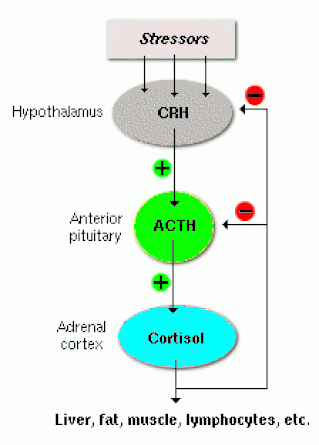
In emergencies, adrenaline is released by the body to override the homeostatic control of glucose. This is done to promote the breakdown of glycogen into glucose to be used in the emergency. These emergencies are often known as 'fight or flight reactions'.
Adrenaline is secreted by the adrenal glands. The secretion of it leads to increased metabolism, breathing and heart rate. Once the emergency is over, and adrenaline levels drop, the homeostatic controls are once again back in place.
Adrenaline is secreted by the adrenal glands. The secretion of it leads to increased metabolism, breathing and heart rate. Once the emergency is over, and adrenaline levels drop, the homeostatic controls are once again back in place.
A second example of positive feedback centers on reversing extreme damage to the body. Following a penetrating wound, the most immediate threat is excessive blood loss. Less blood circulating means reduced blood pressure and reduced perfusion (penetration of blood) to the brain and other vital organs. If perfusion is severely reduced, vital organs will shut down and the person will die. The body responds to this potential catastrophe by releasing substances in the injured blood vessel wall that begin the process of blood clotting. As each step of clotting occurs, it stimulates the release of more clotting substances. This accelerates the processes of clotting and sealing off the damaged area. Clotting is contained in a local area based on the tightly controlled availability of clotting proteins. This is an adaptive, life-saving cascade of events.

